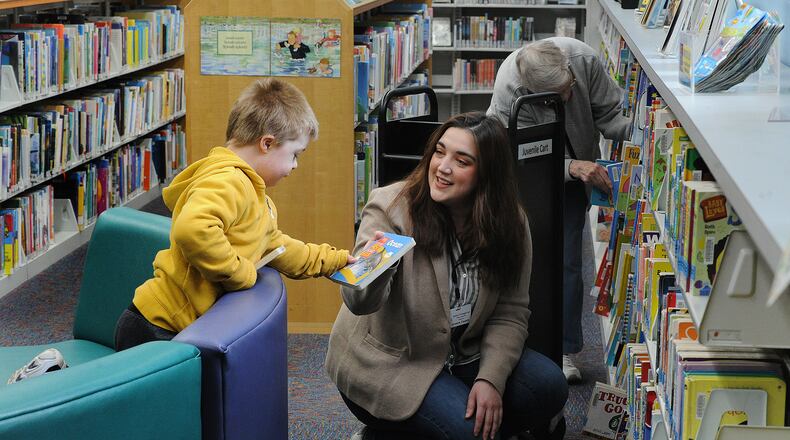“If everyone can get online and stream movies, we have to provide something that meets that expectation,” Potts said.
Public libraries offer access to a multitude of streaming services and ways of accessing content digitally. Overdrive, Kanopy, Hoopla, Ohio Digital Library, and music streaming service Freegal are only a few vendors available through public libraries, all offering access to digital ebooks, audiobooks, movies, TV shows and magazines. Other resources like LinkedIn Learning, and JobNow provide career and job training tools through a library card.
“Our online collection has been a critical way of serving our community wherever it may be, on any given day, anywhere in the world. This is also how we were able to effectively serve our community during the pandemic — with services they already used,” said Karl Colón, executive director of Greene County Public Library.
Wright Memorial Public Library has seen double-digit growth in digital borrowing over the past six years. The library tracks this using a few different models, including streaming for music and videos, and downloaded content for audiobooks and e-books. At Wright Memorial, the cost per circulation, or cost of an item per check out, for digital materials sits at around $2 per item on average.
“If you think about what you would pay per movie, you’d have to watch a lot of movies to get to that same number per movie,” Potts said.
Dayton Metro Library reached 1 million digital checkouts with OverDrive in December 2021. Hoopla downloads ended 2021 at 104,549 downloads, with about 6,000 unique users, and Kanopy ended at 25,645 downloads, with over 4,000 accounts. Dayton Metro Library launched access to PressReader in 2021, which offers patrons access to newspapers all over the world.
“In a year’s time, our digital collection jumped from approximately 80 to almost 100 individual databases available for access,” Development Director Diane Farrell said.
Traditional paid streaming services are also accessible through public libraries. In March of this year, Dayton began circulating Rokus to the public, which are connected to any one of nine premium streaming services. These subscriptions include Apple TV+, Discovery+, Disney+, HBO Max, Hulu, Netflix, Paramount+, Peacock Premium and Amazon Prime Video. The library currently has over 180 Rokus in circulation, with about 50 on reserve. Since their testing date in February, the Rokus have seen approximately 530 checkouts.
| Library | Movies | TV Shows | Unique Patrons* |
|---|---|---|---|
| Greene County Public Library | 42,725 | 46,799 | 11,925 |
| Clermont County Public Library | 5,546 | 4,122 | 9,504 |
| Dayton Metro Library | 29,642 | 27,370 | 12,203 |
| Lane Libraries | 6,124 | 3,638 | 28,480 |
| MidPointe Library System | 18,008 | 15,869 | 19,719 |
| Washington Centerville Public Library | 13,558 | 10,587 | 26,005 |
| *For all digital materials | |||
| TOTALS | 115,603 | 108,385 | 107,836 |
“Dayton taxpayers see a $4.16 return in value on every $1 invested,” Farrell said. “However, many of the most responsive and innovative services, streaming, Take and Make Kits, virtual programming, are so new that they aren’t even incorporated into industry standard ROI calculations.”
Libraries have been hubs for COVID-19 related resources, like distributing take-home tests and, in Dayton Metro’s case, vaccine clinics. Greene County has a “makerspace” where patrons can come in and use things like sewing machines and 3D printers. Other services, like Dayton’s Take and Make Kits, or Makerboxes from Wright Memorial, are ways for libraries to check out physical items other than books.
Juliet Glaser recently checked out a pottery wheel from Wright Memorial Library, and has used it to help her children try out new hobbies.
“It’s just fun, because I personally am not going to buy a pottery wheel,” she said. “The kids have a blast using it, we return it and try something else.”
The trend toward the so-called “library of things” also makes supplies for crafts more accessible, she said.
“Not everyone needs to own a sewing machine. You may need one for a specific project,” Glaser said. “It helps in terms of sustainability but also creates sense of community. It’s a great equalizer because everyone has access to the same opportunities, resources, and that doesn’t exist in too many places anymore.”
Glaser said that her family subscribes to Netflix, Hulu and Disney+, and they still check out DVDs from the library.
“It sounds really old fashioned,” she said. “I come from the Blockbuster generation, though, so it doesn’t feel old fashioned to me.”
About the Author

